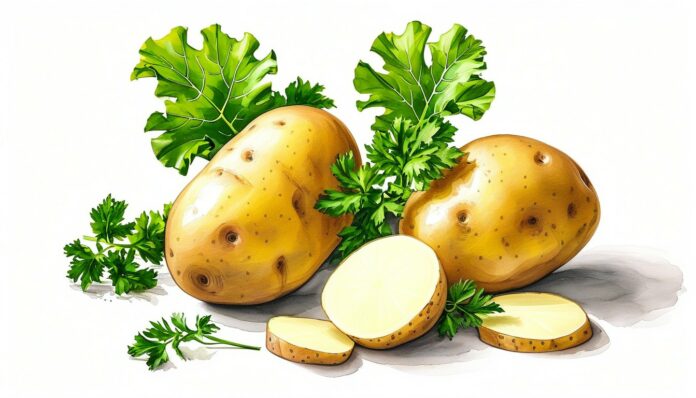Many of us eat potatoes almost every day, and in the diet of an average European, this product holds a very important place. However, this wasn’t always the case, and before the discovery of the New World, potatoes were only known to the indigenous people of the Americas. Thanks to the discoveries of Christopher Columbus, the rest of humanity learned about this tasty and nutritious tuber.
Facts About Potatoes:
- Introduction to the U.S.: Potatoes were introduced to North America in the early 17th century by European settlers. They quickly became a staple crop due to their adaptability and nutritional value.
- Idaho’s Famous Potatoes: Idaho is the leading potato producer in the United States, known for its Russet Burbank potatoes. The state produces over 30% of the nation’s potatoes, and “Idaho potatoes” are famous worldwide for their quality.
- Potato Chip Invention: The potato chip, one of America’s favorite snacks, was invented in Saratoga Springs, New York, in 1853. A chef named George Crum created the first batch after a customer complained that his fried potatoes were too thick.
- Potato’s Role in American History: During World War II, potatoes played a crucial role in the U.S. food supply. They were easy to grow and provided essential nutrients, helping to feed the nation and troops overseas.
- National Potato Day: In the U.S., National Potato Day is celebrated on August 19th, a day to honor and enjoy all things potato, from fries to baked potatoes to mashed potatoes.
- Potato Diversity in the U.S.: The United States grows over 200 different types of potatoes, including a variety of colors such as white, yellow, red, blue, and purple. This diversity allows for a wide range of culinary uses.
- Popularity of French Fries: French fries, which are deeply rooted in American culture, account for a significant portion of potato consumption in the U.S. They are a staple in fast food and are often served as a side dish in restaurants across the country.
- Botanically speaking, tomatoes and eggplants are related to potatoes.
- Wild potatoes are found only in South America.
- Until the end of the 18th century, potatoes were hardly consumed in Europe. Many believed that they caused leprosy and other incurable diseases.
- The French agronomist Antoine-Auguste Parmentier used a psychological trick to get his fellow citizens accustomed to potatoes. His field was heavily guarded during the day, not allowing anyone close to the area. At night, however, there was no guard, and people took advantage of this to steal some potatoes—everyone was curious about why they were so well protected.
- There are quite a few varieties of potatoes. They differ not only in appearance (white, purple, dark, etc.) but also in starch content and other substances.
- Before the introduction of potatoes into the Russian diet, the main root vegetable grown everywhere was the turnip, with rutabaga in second place. Fields were sown with them, and they were featured in folk tales. There are no Russian folk tales about potatoes for this very reason.
- Everyone knows that if you drop iodine on a potato, it turns blue. However, there are potato varieties that are naturally blue, not only in their skin but also in their flesh. One common variety with such a feature is Linzer Blaue.
- Beyond cooking, potatoes were used in Incan culture for medicinal purposes. Slices of raw potatoes were applied to broken bones to speed up healing, and they were used as a preventive measure against rheumatism and toothaches.
- This tuber is composed of about 80% water.
- A medium-sized potato contains only about 100 calories.
- In France, potatoes, nicknamed “earth apples,” became known in 1600. Initially, this unfamiliar product was deemed poisonous by French doctors, and in 1630, the French parliament even banned the cultivation of potatoes.
- People first began consuming this tuber about 8,000 years ago.
- Potatoes contain more potassium than bananas, more vitamin C than oranges, and more fiber than apples.
- French Queen Marie Antoinette loved potato flowers so much that she used them to decorate her hair.
- The poisonous plant belladonna belongs to the same nightshade family as potatoes.
- Gastroenterologists and nutrition experts have ranked potato dishes by their harm to the body. French fries topped the list, as the large amount of fat and spices harms digestion and contributes to weight gain.
- Potatoes are perennial plants. We dig them up annually because we’re interested in the tubers. However, if left alone, potato bushes would continue to grow.
- A major advocate of potatoes was the Russian writer Mikhail Mikhaylovich Prishvin. He authored a serious scientific work, “Potatoes in Field and Garden Cultivation,” published in 1908.
- If you see green or greenish-brown spots on a potato, throw it away. Such a vegetable is not only unsuitable for consumption but also very harmful. Green potatoes contain a lot of solanine, a toxic substance that is difficult to digest and even harder to eliminate from the body.
- Potatoes cooked with the skin are only beneficial when young. The longer a tuber remains in the ground, the more solanine accumulates in its skin.
- The starch content in potato tubers can reach 15%.
- Potatoes were the first vegetable grown outside our planet. This happened in 1995 aboard the American space shuttle “Columbia.”
